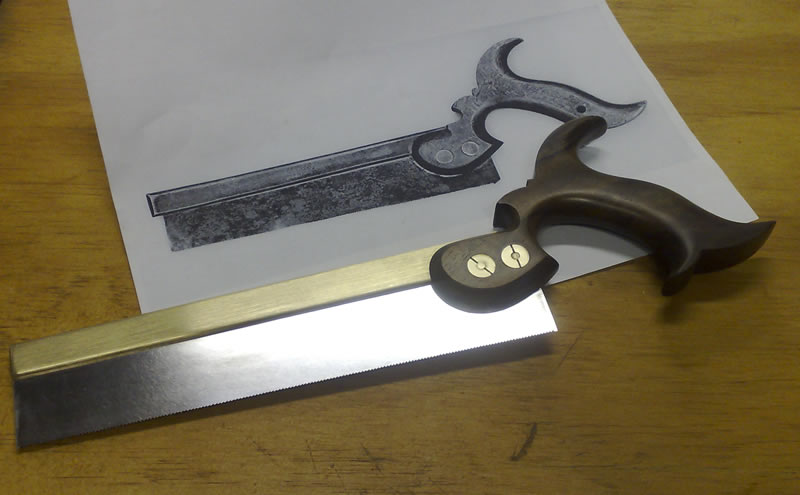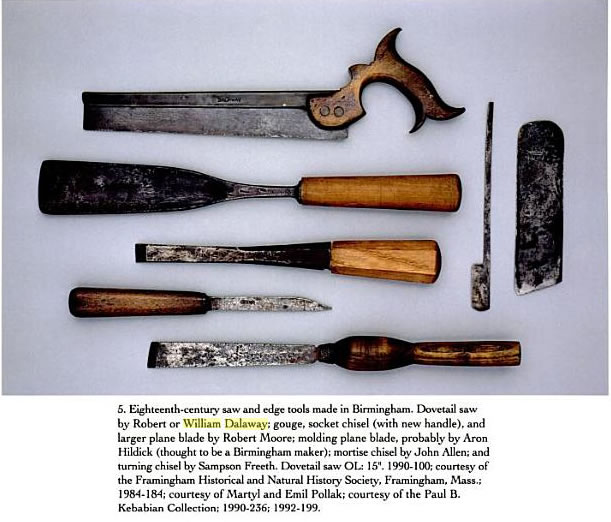 Thanks: 0
Thanks: 0
 Needs Pictures: 0
Needs Pictures: 0
 Picture(s) thanks: 0
Picture(s) thanks: 0
Results 1 to 7 of 7
Thread: Early 19th century handsaws.
-
8th December 2013, 10:30 AM #1
 Deceased
Deceased











- Join Date
- May 2008
- Location
- Australia
- Posts
- 2,357
 Early 19th century handsaws.
Early 19th century handsaws.
Story of the Saw. P. d' A. Jones and E. N. Simons. Spear&Jackson Limited 1760-1960. Illustrations of Early 19th century handsaws. Page 32, Toolemera Press. (PDF) http://toolemera.com/bkpdf/Story%20o...e%20Saw(2).pdf , it shows a Dovetail Saw with a much lower handle hang to that seen generally on more modern day dts. It does makes one think why the change to a higher hang took place and the merits of doing so. Was it to accommodate the more modern use of smaller depth of saw plate on dt's , resulting in the handle itself having to be altered to a higher set so that the bottom horns would remain proud of the tooth line so this same saw could also be used proficiently on a bench hook. We are left to only speculate the reasons why as their is most likely no documented history that would categorically answer this question. A most interesting subject.
Stewie;
-
8th December 2013 10:30 AM # ADSGoogle Adsense Advertisement
- Join Date
- Always
- Location
- Advertising world
- Posts
- Many
-
9th December 2013, 12:03 AM #2

Hi Stewie,
I've got that book, it's a great read, and gives a reasonable overview of the history of the saw.
My general feeling is that early small saws ( dovetail saws particularly) had fairly high hang angles rather than lower hang angles. The example that springs to mind is the Duncan Phyfe saw that was the inspiration for the Grammercy DT that TFWW sells, the early Kenyon dovetail saws, from the Seaton tool chest all had fairly high hang angles as well.. A few other early Birmingham saws like Dallaway and Barnard examples also had high hang angles.
Here's some samples.
This is a Barnard, made in Birmingham around 1790 ish, name was stamped on the saw plate rather than the back.
Mike Wenzloff's copies of the Seaton tool chest..

The Grammercy 9" DT saw, copied from the Duncan Phyfe toolchest, fairly extreme example of high hang angle
My left handed copy of the 1780's Kenyon DT

Another Birmingham maker, Dallaway.. again high hang angle..

The engravings of the saws in Smith's Key (1816) show a lower hang angle for the DT saw, but the picture looks like a longer looking Joinery saw...

Here's a Birmingham saw by Dallaway that looks a bit more like the Smith's Key saw.. ?
Saw Discussion Forums - View Single Post - New to me. Dalaway?
Regards
Ray
-
9th December 2013, 10:24 AM #3
 Deceased
Deceased











- Join Date
- May 2008
- Location
- Australia
- Posts
- 2,357

Thanks for your thoughts Ray. Nicely presented as well. Of interest the 2 shorter backsaws shown in the Smiths Key engravings (dt & carcass) both have canted blades.
-
9th December 2013, 02:08 PM #4
-
9th December 2013, 03:01 PM #5
 Deceased
Deceased











- Join Date
- May 2008
- Location
- Australia
- Posts
- 2,357

Your right Ray. I failed to notice the canted spines. Yes, the extra long early Kenyon backsaw that Matt shows on his blog certainly exhibits a lot of cant in the blade. I notice the backsaw that Matt rehandled for Peter Follansbee using a Kenyon Sykes design, IMO lacks a certain appeal when fitted to a constant depth blade. Maybe this handle shape needs to be matched to a canted blade to give it that right look. You mention that canted blades drifted out of fashion by the 1800's. Whats you personal thoughts on the mechanical advantages from their use, apart from the slightly lighter feel in front of the handle.
Stewie;
-
9th December 2013, 03:20 PM #6

Could the canting have some crossover to please the eye from the shape of panel saws? I only say this because the cant is quite extreme in the etchings and the proportions see similar to the panel saw. Nothing historical to back this up just my personal observation.
…..Live a Quiet Life & Work with your Hands
-
9th December 2013, 04:30 PM #7
 Deceased
Deceased











- Join Date
- May 2008
- Location
- Australia
- Posts
- 2,357

Hi Dale. Most standard hand saws have 26" long blades - those with shorter blades that still look like a classic hand saw are known as panel saws. Panel saws are quite simply just shorter saws where the blades are from 16" to 24" (some say 14" to 20") in length and are usually crosscut.
Stewie;
Similar Threads
-
Shepherds’ Compleat Early Nineteenth Century Woodworker
By pmcgee in forum HAND TOOLS - UNPOWEREDReplies: 0Last Post: 5th February 2013, 01:20 AM -
Early 20th century Carpenters Tool-chest
By pmcgee in forum HAND TOOLS - UNPOWEREDReplies: 2Last Post: 25th December 2012, 07:12 AM -
Next Turn-on 18th-19th OCT.
By RETIRED in forum WOODTURNING - GENERALReplies: 302Last Post: 24th October 2008, 09:24 AM -
Open Day Saturday 19th April
By Gwhat in forum WOODIES EVENTSReplies: 7Last Post: 19th April 2008, 07:40 AM



 Likes:
Likes: 
 Reply With Quote
Reply With Quote

